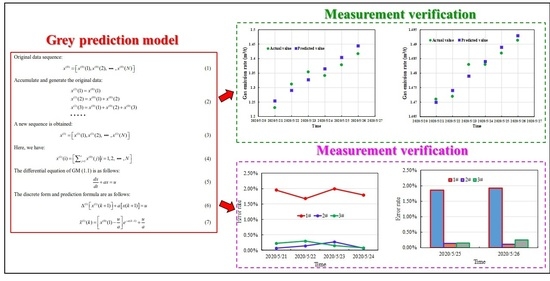Research on Prediction Accuracy of Coal Mine Gas Emission Based on Grey Prediction Model
Abstract
1. Introduction
2. Brief Introduction of Grey Prediction Method
2.1. Characteristics of Grey Prediction Theory
2.2. Calculation Process of Grey Prediction Model
3. Grey Prediction Model of Gas Emission
3.1. General Situation of Coal Mine Geology
3.2. Grey Prediction Analysis of Gas Emission in Coal Mining Face
3.3. Grey Prediction Analysis of Gas Emission in Intake and Return Air Roadway of Working Face
4. Comparison between the Predicted Results and the Actual Values
5. Conclusions
Author Contributions
Funding
Institutional Review Board Statement
Informed Consent Statement
Data Availability Statement
Conflicts of Interest
References
- Sun, H.; Cao, J.; Li, M.; Zhao, X.; Dai, L.; Sun, D.; Wang, B.; Zhai, B. Experimental research on the impactive dynamic effect of gas-pulverized coal of coal and gas outburst. Energies 2018, 11, 797. [Google Scholar] [CrossRef]
- Mou, J.; Liu, H.; Zou, Y.; Li, Q. A new method to determine the sensitivity of coal and gas outburst prediction index. Arab. J. Geosci. 2020, 13, 1–9. [Google Scholar] [CrossRef]
- Wang, K.; Du, F. Coal-gas compound dynamic disasters in China: A review. Process. Saf. Environ. Prot. 2020. [Google Scholar] [CrossRef]
- D’Alessandro, W.; Kyriakopoulos, K. Preliminary gas hazard evaluation in Greece. Nat. Hazards 2013. [Google Scholar] [CrossRef]
- Ke, W.; Wang, K. Impact of gas control policy on the gas accidents in coal mine. Processes 2020, 8, 1450. [Google Scholar] [CrossRef]
- Xu, H.; Wang, G.; Guo, Y.; Chang, B.; Hu, Y.; Fan, J. Theoretical, numerical, and experimental analysis of effective extraction radius of coalbed methane boreholes by a gas seepage model based on defined criteria. Energy Sci. Eng. 2020, 8, 880–897. [Google Scholar] [CrossRef]
- Tong, R.; Yang, Y.; Ma, X.; Zhang, Y.; Li, S.; Yang, H. Risk assessment of Miners’ unsafe behaviors: A case study of gas explosion accidents in coal mine, china. Int. J. Environ. Res. Public Health 2019, 16, 1765. [Google Scholar] [CrossRef]
- Wang, L.; Lu, Z.; Chen, D.P.; Liu, Q.Q.; Chu, P.; Shu, L.Y.; Wen, Z.J. Safe strategy for coal and gas outburst prevention in deep-and-thick coal seams using a soft rock protective layer mining. Saf. Sci. 2020. [Google Scholar] [CrossRef]
- Zhou, H.; Dai, H.; Ge, C. Quality and quantity of pre-drainage methane and responding strategies in Chinese outburst coal mines. Arab. J. Geosci. 2016. [Google Scholar] [CrossRef]
- Geng, F.; Saleh, J.H. Challenging the emerging narrative: Critical examination of coalmining safety in China, and recommendations for tackling mining hazards. Saf. Sci. 2015. [Google Scholar] [CrossRef]
- Wang, H.; Cheng, Y.; Yuan, L. Gas outburst disasters and the mining technology of key protective seam in coal seam group in the Huainan coalfield. Nat. Hazards 2013. [Google Scholar] [CrossRef]
- Dong, G.; Ren, X.; Wang, Z. A novel early-warning method for atypical outbursts disasters in mines: Extraction of indexes from gas concentration data for the early warning of atypical outbursts. Arab. J. Geosci. 2019. [Google Scholar] [CrossRef]
- Xu, N.; Ding, S.; Gong, Y.; Bai, J. Forecasting Chinese greenhouse gas emissions from energy consumption using a novel grey rolling model. Energy 2019. [Google Scholar] [CrossRef]
- Li, Z.; Wang, E.; Ou, J.; Liu, Z. Hazard evaluation of coal and gas outbursts in a coal-mine roadway based on logistic regression model. Int. J. Rock Mech. Min. Sci. 2015. [Google Scholar] [CrossRef]
- Yang, Y.; Du, Q.; Wang, C.; Bai, Y. Research on the Method of Methane Emission Prediction Using Improved Grey Radial Basis Function Neural Network Model. Energies 2020, 13, 6112. [Google Scholar] [CrossRef]
- Wei, C.; Xu, M.; Sun, J.; Li, X.; Ji, C. Coal mine gas emission gray dynamic prediction. Procedia Eng. 2011, 26, 1157–1167. [Google Scholar] [CrossRef][Green Version]
- Ruilin, Z.; Lowndes, I.S. The application of a coupled artificial neural network and fault tree analysis model to predict coal and gas outbursts. Int. J. Coal Geol. 2010. [Google Scholar] [CrossRef]
- Zhu, Z.; Zhang, H.; Han, J. Prediction of Coal and Gas Outburst Based on PCA-BP Neural Network. China Saf. Sci. J. 2013, 23, 45–50. [Google Scholar] [CrossRef]
- Zhang, S.; Wang, B.; Li, X.; Chen, H. Research and Application of Improved Gas Concentration Prediction Model Based on Grey Theory and BP Neural Network in Digital Mine. Procedia CIRP 2016, 56, 471–475. [Google Scholar] [CrossRef]
- Chen, Y.; Zheng, L.; Huang, J.; Zou, Z.; Li, C. Prediction of gas emission based on grey-generalized regression neural network. IOP Conf. Ser. Earth Environ. Sci. 2020, 467. [Google Scholar] [CrossRef]
- Li, Y. Study on the Application of Multi-Source Information FusionTechnology in the Coal and Gas Outburst Prediction; China University of Mining and Technology: Beijing, China, 2018. [Google Scholar]
- Zhang, F.; Han, H. Location method of mine gas diffusive position based on multi-source sensor. Meitan Xuebao J. China Coal Soc. 2018. [Google Scholar] [CrossRef]
- Liu, Z.; Pang, J. Research on coal mine safety monitoring system based on multi-sensor fusion technology. China Energy Environ. Prot. 2017, 39, 39–42. [Google Scholar]
- Dong, D. Mine gas emission prediction based on Gaussian process model. Procedia Eng. 2012, 45, 334–338. [Google Scholar] [CrossRef]
- Jing, G.X.; Xu, S.M.; Heng, X.W.; Li, C.Q. Research on the prediction of gas emission quantity in coal mine based on grey system and linear regression for one element. Procedia Eng. 2011, 26, 1585–1590. [Google Scholar] [CrossRef][Green Version]
- Wu, Y.; Gao, R.; Yang, J. Prediction of coal and gas outburst: A method based on the BP neural network optimized by GASA. Process. Saf. Environ. Prot. 2020, 133, 64–72. [Google Scholar] [CrossRef]
- Yin, G.Z.; Li, M.H.; Li, W.P.; Cao, J.; Li, X. Model of coal gas permeability prediction based on improved BP neural network. Meitan Xuebao J. China Coal Soc. 2013, 38, 1179–1184. [Google Scholar] [CrossRef]
- Tian, S.; Lin, H.; Ma, R. Prediction of correlation between gas emission and tectonic coal. China Saf. Sci. J. 2019, 29, 105–109. [Google Scholar]
- Gao, K.; Liu, J.; Liu, Y. Gas emission prediction of working face based on GA-projection pursuit regression. China Saf. Sci. J. 2015, 25, 96–101. [Google Scholar]
- Xiao, P.; Xie, X.; Shuang, H. Prediction of gas emission quantity based on KPCA-CMGANN algorithm. China Saf. Sci. J. 2020, 30, 39–47. [Google Scholar]
- Li, R.; Shi, S.; Wu, A.; Luo, W.; Zhu, H. Research on prediction of gas emission based on self-organizing data mining in coal mines. Procedia Eng. 2014, 84, 779–785. [Google Scholar] [CrossRef]
- Deng, J. Control problems of grey systems. Syst. Control. Lett. 1982. [Google Scholar] [CrossRef]
- Chang, C.J.; Li, D.C.; Huang, Y.H.; Chen, C.C. A novel gray forecasting model based on the box plot for small manufacturing data sets. Appl. Math. Comput. 2015. [Google Scholar] [CrossRef]
- Wu, L.; Liu, S.; Yang, Y. A Gray Model with a Time Varying Weighted Generating Operator. IEEE Trans. Syst. Man Cybern. Syst. 2016. [Google Scholar] [CrossRef]
- Shou, M.H.; Wang, Z.X.; Li, D.D.; Wang, Y. Assessment of the air pollution emission reduction effect of the coal substitution policy in China: An improved grey modelling approach. Environ. Sci. Pollut. Res. 2020, 27, 34357–34368. [Google Scholar] [CrossRef]
- Yang, F.; Jiao, Y.; Zhang, J.; Gao, D.; Zhao, K.; Ma, D. Study on simultaneous extraction of coal and gas and clean utilization in high-gas outburst mines. IOP Conf. Ser. Earth Environ. Sci. 2020, 510. [Google Scholar] [CrossRef]
- Wang, Z.X.; He, L.Y.; Zheng, H.H. Forecasting the residential solar energy consumption of the United States. Energy 2019. [Google Scholar] [CrossRef]
- Ikram, M.; Mahmoudi, A.; Shah, S.Z.A.; Mohsin, M. Forecasting number of ISO 14001 certifications of selected countries: Application of even GM (1,1), DGM, and NDGM models. Environ. Sci. Pollut. Res. 2019. [Google Scholar] [CrossRef]
- Zeng, B.; Tong, M.; Ma, X. A new-structure grey Verhulst model: Development and performance comparison. Appl. Math. Model. 2020. [Google Scholar] [CrossRef]
- Wu, L.; Liu, S.; Chen, D.; Yao, L.; Cui, W. Using gray model with fractional order accumulation to predict gas emission. Nat. Hazards 2014, 71, 2231–2236. [Google Scholar] [CrossRef]
- Wang, Y.; Yao, D.; Lu, H. Mine Gas Emission Prediction Based on Grey Markov Prediction Model. Open J. Geol. 2018, 8, 939–946. [Google Scholar] [CrossRef][Green Version]
- Yuan, B. Study on gas emission prediction of working face based on GM (1, 1) model. J. Phys. Conf. Ser. 2020, 1549. [Google Scholar] [CrossRef]
- Xu, N.; Dang, Y. Characteristic adaptive GM(1, 1) model and forecasting of Chinese traffic pollution emission. Xitong Gongcheng Lilun Yu Shijian Syst. Eng. Theory Pract. 2018. [Google Scholar] [CrossRef]
- Wang, W.; Peng, L.; Wang, X. Prediction of coal mine gas emission quantity based on grey-gas geologic method. Math. Probl. Eng. 2018, 2018. [Google Scholar] [CrossRef]
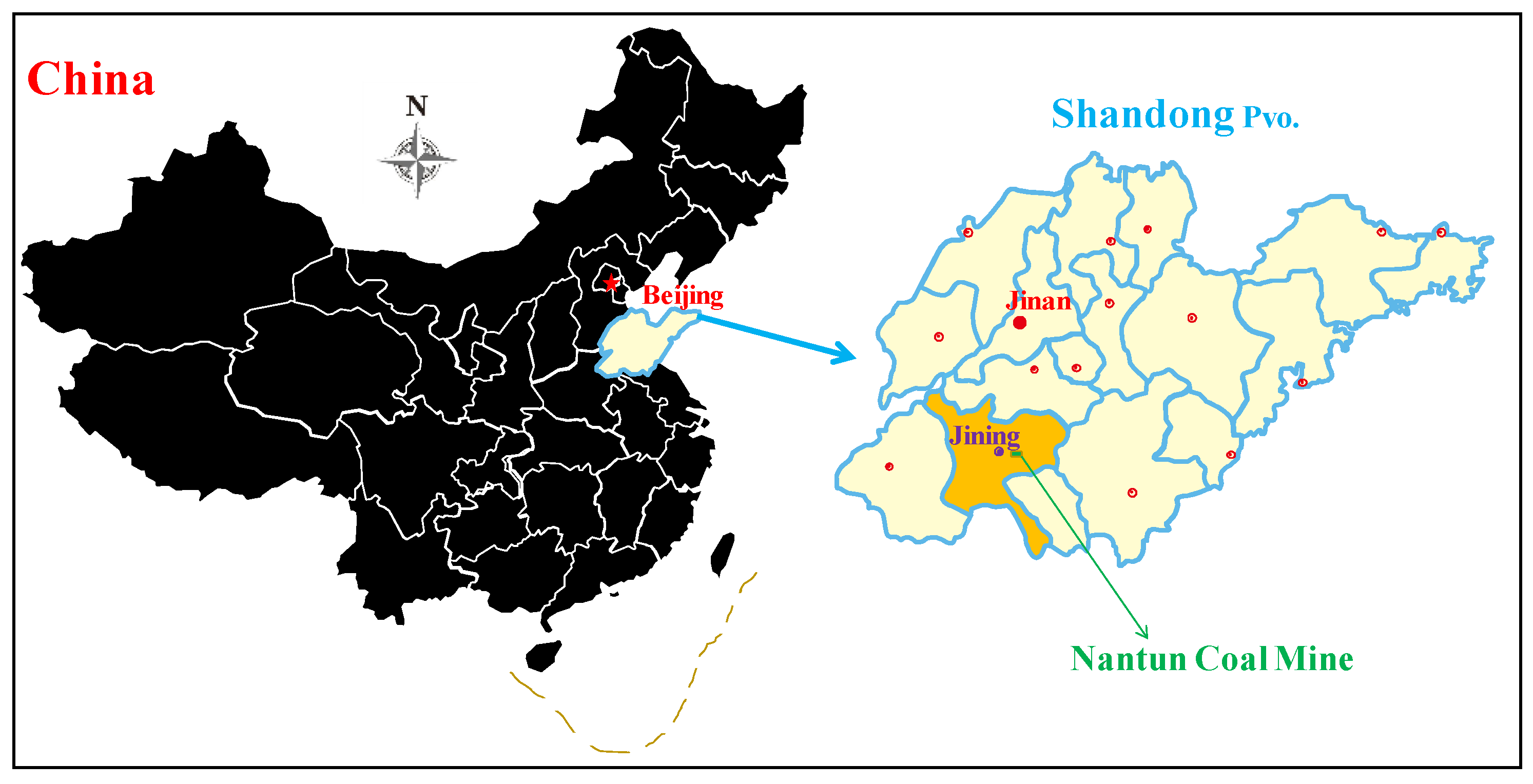
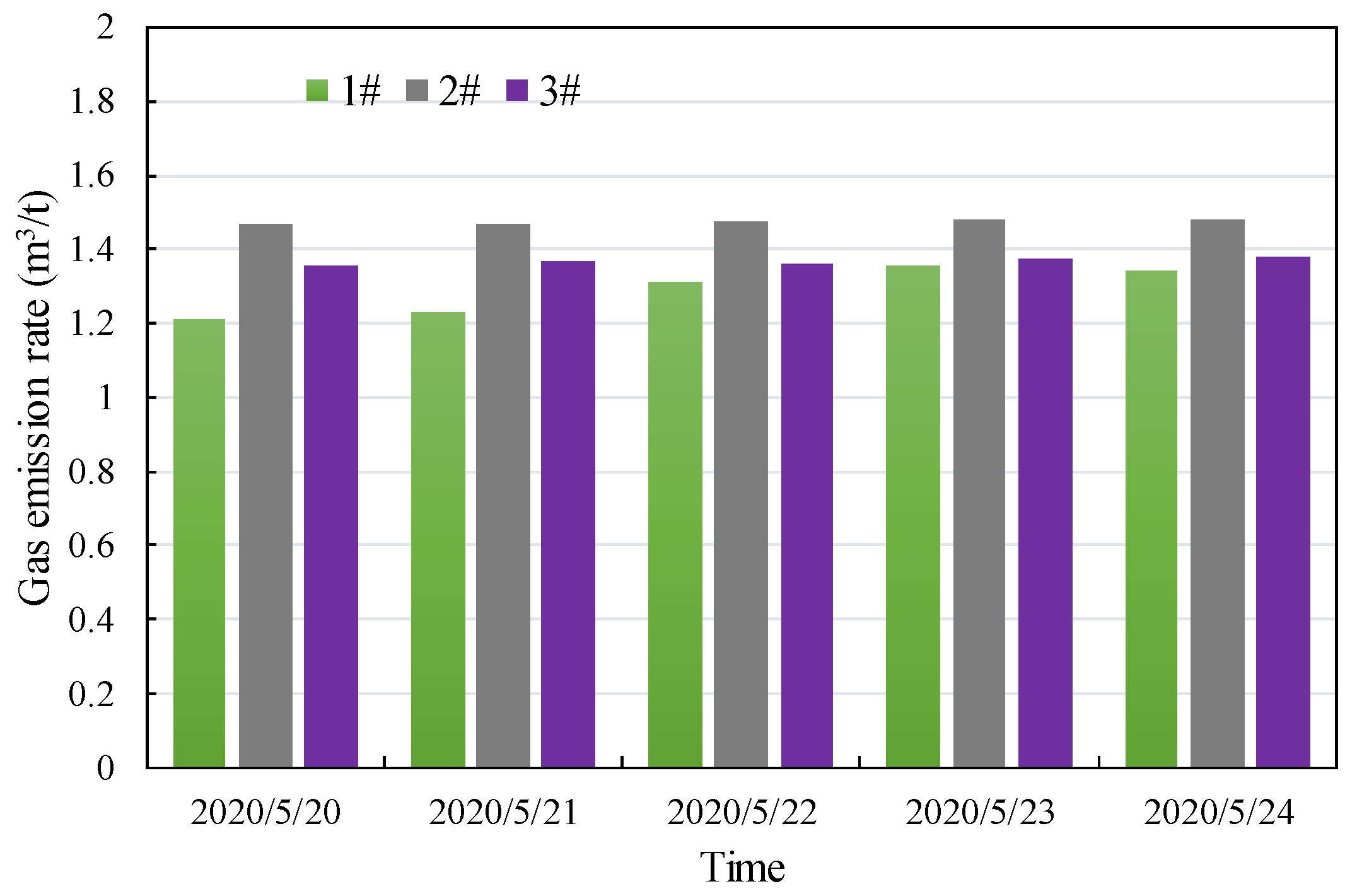
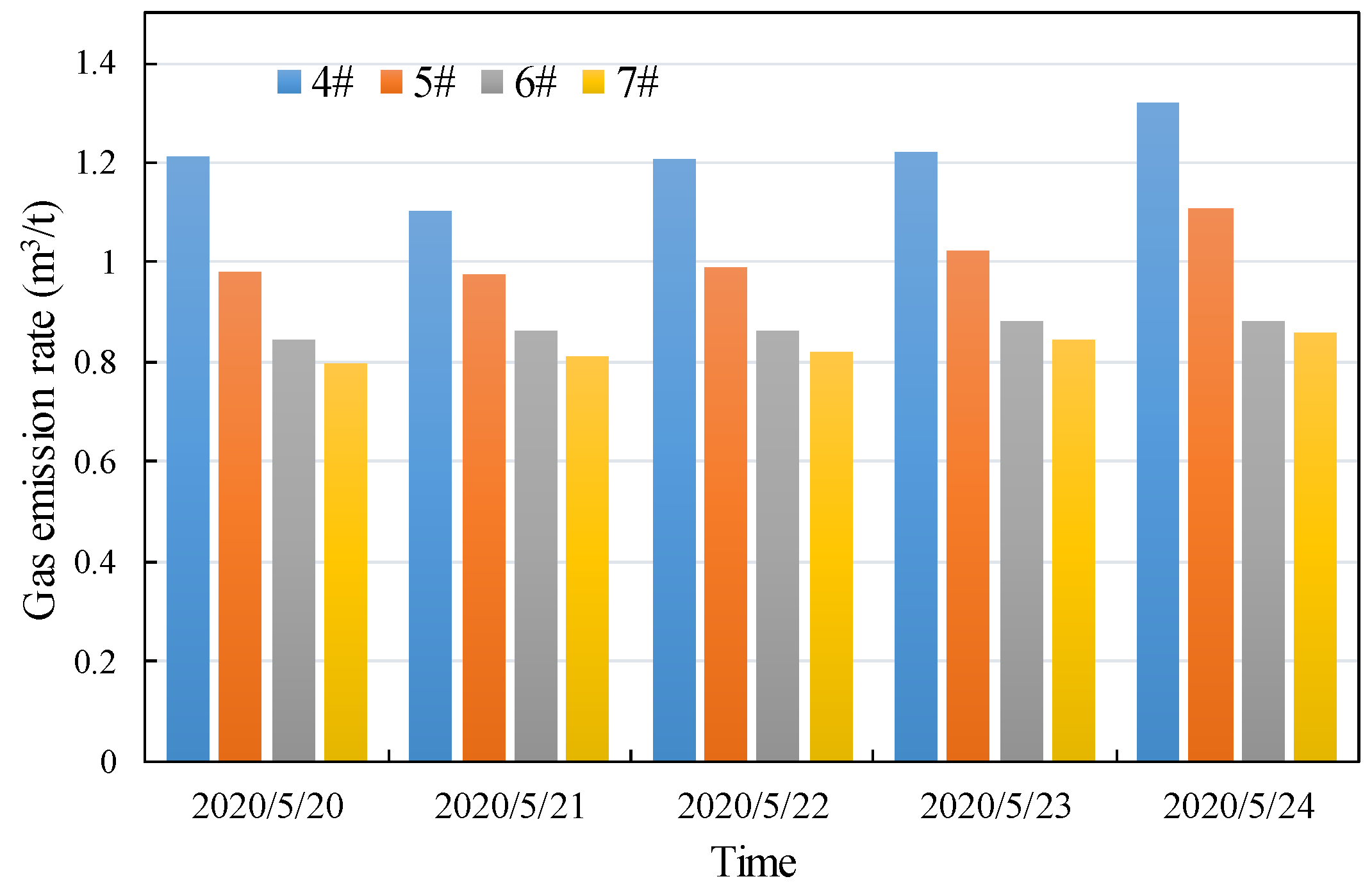
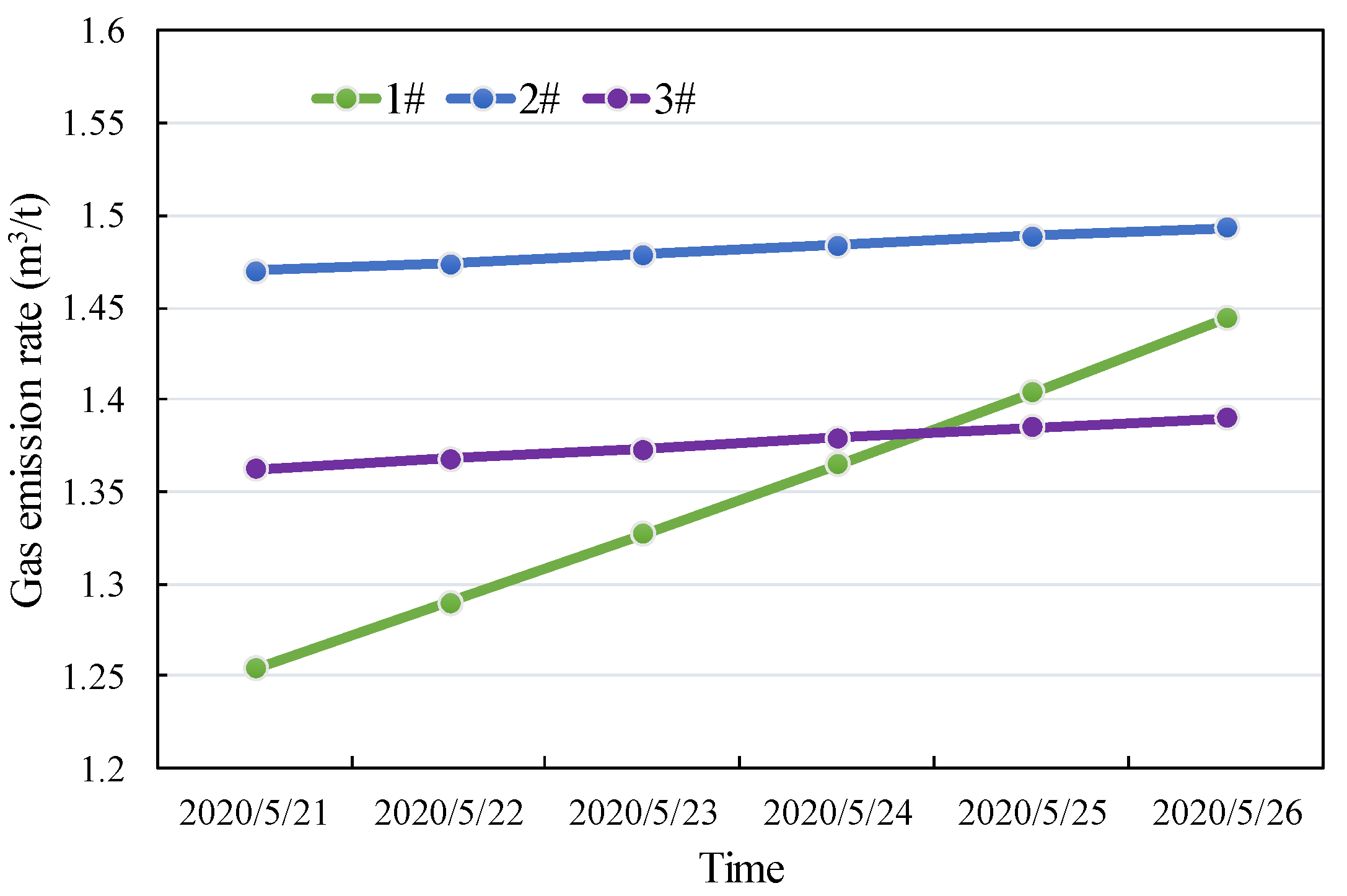

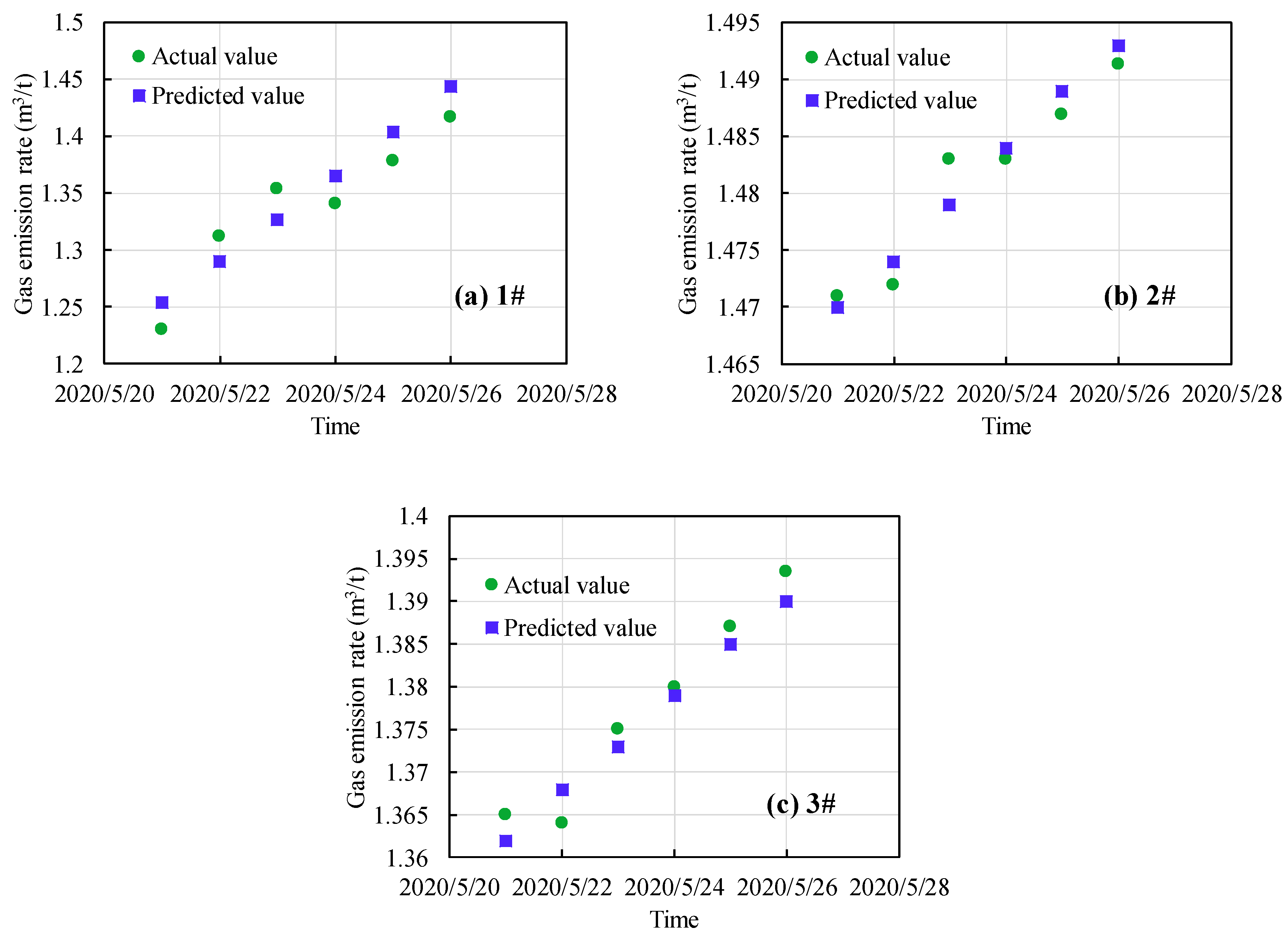

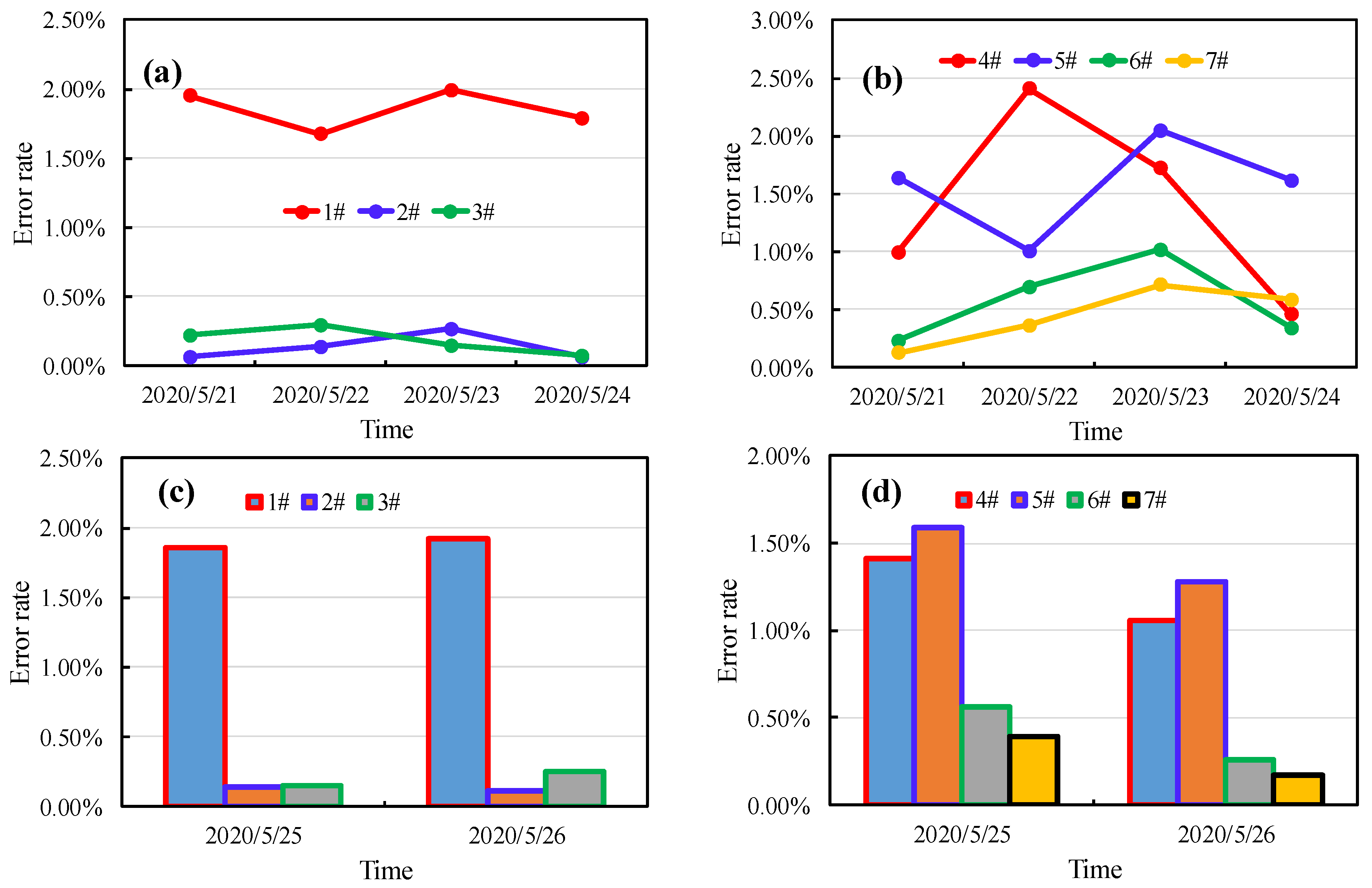
| Working Face Name | No. | 5/20 | 5/21 | 5/22 | 5/23 | 5/24 |
|---|---|---|---|---|---|---|
| 411205 working face/(m3/t) | 1# | 1.211 | 1.23 | 1.312 | 1.354 | 1.341 |
| 411702 working face/(m3/t) | 2# | 1.467 | 1.471 | 1.472 | 1.483 | 1.483 |
| 411306 working face/(m3/t) | 3# | 1.354 | 1.365 | 1.364 | 1.375 | 1.38 |
| Intake air roadway of 411103 working face/(m3/t) | 4# | 1.212 | 1.102 | 1.205 | 1.221 | 1.318 |
| Return air roadway of 411103 working face/(m3/t) | 5# | 0.981 | 0.974 | 0.991 | 1.024 | 1.11 |
| Intake air roadway of 411501 working face/(m3/t) | 6# | 0.845 | 0.861 | 0.861 | 0.884 | 0.881 |
| Return air roadway of 411501 working face/(m3/t) | 7# | 0.798 | 0.812 | 0.822 | 0.844 | 0.857 |
| No. | 5/21 | 5/22 | 5/23 | 5/24 | 5/25 | 5/26 |
|---|---|---|---|---|---|---|
| 1#/(m3/t) | 1.254 | 1.29 | 1.327 | 1.365 | 1.404 | 1.444 |
| 2#/(m3/t) | 1.47 | 1.474 | 1.479 | 1.484 | 1.489 | 1.493 |
| 3#/(m3/t) | 1.362 | 1.368 | 1.373 | 1.379 | 1.385 | 1.39 |
| No. | 5/21 | 5/22 | 5/23 | 5/24 | 5/25 | 5/26 |
|---|---|---|---|---|---|---|
| 4#/(m3/t) | 1.113 | 1.176 | 1.242 | 1.312 | 1.386 | 1.465 |
| 5#/(m3/t) | 0.958 | 1.001 | 1.045 | 1.092 | 1.141 | 1.192 |
| 6#/(m3/t) | 0.859 | 0.867 | 0.875 | 0.884 | 0.892 | 0.901 |
| 7#/(m3/t) | 0.811 | 0.825 | 0.838 | 0.852 | 0.866 | 0.88 |
| No. | 5/21 | 5/22 | 5/23 | 5/24 | 5/25 | 5/26 |
|---|---|---|---|---|---|---|
| 1#/(m3/t) | 1.95% | 1.68% | 1.99% | 1.79% | 1.86% | 1.92% |
| 2#/(m3/t) | 0.07% | 0.14% | 0.27% | 0.07% | 0.14% | 0.11% |
| 3#/(m3/t) | 0.22% | 0.29% | 0.15% | 0.07% | 0.15% | 0.25% |
| 4#/(m3/t) | 1.00% | 2.41% | 1.72% | 0.46% | 1.41% | 1.06% |
| 5#/(m3/t) | 1.64% | 1.01% | 2.05% | 1.62% | 1.59% | 1.28% |
| 6#/(m3/t) | 0.23% | 0.70% | 1.02% | 0.34% | 0.56% | 0.26% |
| 7#/(m3/t) | 0.12% | 0.36% | 0.71% | 0.58% | 0.39% | 0.17% |
Publisher’s Note: MDPI stays neutral with regard to jurisdictional claims in published maps and institutional affiliations. |
© 2021 by the authors. Licensee MDPI, Basel, Switzerland. This article is an open access article distributed under the terms and conditions of the Creative Commons Attribution (CC BY) license (https://creativecommons.org/licenses/by/4.0/).
Share and Cite
Zeng, J.; Li, Q. Research on Prediction Accuracy of Coal Mine Gas Emission Based on Grey Prediction Model. Processes 2021, 9, 1147. https://doi.org/10.3390/pr9071147
Zeng J, Li Q. Research on Prediction Accuracy of Coal Mine Gas Emission Based on Grey Prediction Model. Processes. 2021; 9(7):1147. https://doi.org/10.3390/pr9071147
Chicago/Turabian StyleZeng, Jun, and Qinsheng Li. 2021. "Research on Prediction Accuracy of Coal Mine Gas Emission Based on Grey Prediction Model" Processes 9, no. 7: 1147. https://doi.org/10.3390/pr9071147
APA StyleZeng, J., & Li, Q. (2021). Research on Prediction Accuracy of Coal Mine Gas Emission Based on Grey Prediction Model. Processes, 9(7), 1147. https://doi.org/10.3390/pr9071147





